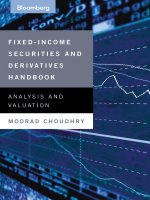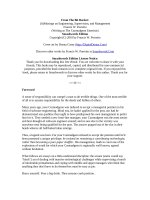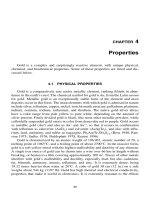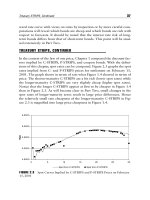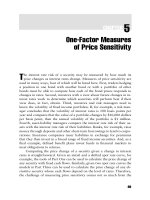Professional perspectives on fixed income portfolio management volume 4
Bạn đang xem bản rút gọn của tài liệu. Xem và tải ngay bản đầy đủ của tài liệu tại đây (8.46 MB, 466 trang )
Frontmatter-Prof Persp Page iii Thursday, July 24, 2003 10:09 AM
Professional Perspectives on
Fixed Income
Portfolio
Management
Volume 4
FRANK J. FABOZZI
EDITOR
John Wiley & Sons, Inc.
Frontmatter-Prof Persp Page i Thursday, July 24, 2003 10:09 AM
Professional Perspectives on
Fixed Income
Portfolio
Management
Volume 4
Frontmatter-Prof Persp Page ii Thursday, July 24, 2003 10:09 AM
THE FRANK J. FABOZZI SERIES
Fixed Income Securities, Second Edition by Frank J. Fabozzi
Focus on Value: A Corporate and Investor Guide to Wealth Creation by James L.
Grant and James A. Abate
Handbook of Global Fixed Income Calculations by Dragomir Krgin
Managing a Corporate Bond Portfolio by Leland E. Crabbe and Frank J. Fabozzi
Real Options and Option-Embedded Securities by William T. Moore
Capital Budgeting: Theory and Practice by Pamela P. Peterson and Frank J.
Fabozzi
The Exchange-Traded Funds Manual by Gary L. Gastineau
Professional Perspectives on Fixed Income Portfolio Management, Volume 3
edited by Frank J. Fabozzi
Investing in Emerging Fixed Income Markets edited by Frank J. Fabozzi and
Efstathia Pilarinu
Handbook of Alternative Assets by Mark J. P. Anson
The Exchange-Traded Funds Manual by Gary L. Gastineau
The Global Money Markets by Frank J. Fabozzi, Steven V. Mann, and
Moorad Choudhry
The Handbook of Financial Instruments edited by Frank J. Fabozzi
Collateralized Debt Obligations: Structures and Analysis by Laurie S. Goodman
and Frank J. Fabozzi
Interest Rate, Term Structure, and Valuation Modeling edited by Frank J. Fabozzi
Investment Performance Measurement by Bruce J. Feibel
The Handbook of Equity Style Management edited by T. Daniel Coggin and
Frank J. Fabozzi
The Theory and Practice of Investment Management edited by Frank J. Fabozzi
and Harry M. Markowitz
Foundations of Economic Value Added: Second Edition by James L. Grant
Financial Management and Analysis: Second Edition by Frank J. Fabozzi and
Pamela P. Peterson
Measuring and Controlling Interest Rate and Credit Risk: Second Edition by
Frank J. Fabozzi, Steven V. Mann, and Moorad Choudhry
Frontmatter-Prof Persp Page iii Thursday, July 24, 2003 10:09 AM
Professional Perspectives on
Fixed Income
Portfolio
Management
Volume 4
FRANK J. FABOZZI
EDITOR
John Wiley & Sons, Inc.
Frontmatter-Prof Persp Page iv Thursday, July 24, 2003 10:09 AM
Copyright © 2003 by Frank J. Fabozzi. All rights reserved.
Published by John Wiley & Sons, Inc., Hoboken, New Jersey
Published simultaneously in Canada
No part of this publication may be reproduced, stored in a retrieval system, or transmitted in
any form or by any means, electronic, mechanical, photocopying, recording, scanning, or otherwise, except as permitted under Section 107 or 108 of the 1976 United States Copyright
Act, without either the prior written permission of the Publisher, or authorization through
payment of the appropriate per-copy fee to the Copyright Clearance Center, Inc., 222 Rosewood Drive, Danvers, MA 01923, 978-750-8400, fax 978-750-4470, or on the web at
www.copyright.com. Requests to the Publisher for permission should be addressed to the Permissions Department, John Wiley & Sons, Inc., 111 River Street, Hoboken, NJ 07030, 201748-6011, fax 201-748-6008, e-mail:
Limit of Liability/Disclaimer of Warranty: While the publisher and author have used their best
efforts in preparing this book, they make no representations or warranties with respect to the
accuracy or completeness of the contents of this book and specifically disclaim any implied
warranties of merchantability or fitness for a particular purpose. No warranty may be created
or extended by sales representatives or written sales materials. The advice and strategies contained herein may not be suitable for your situation. You should consult with a professional
where appropriate. Neither the publisher nor author shall be liable for any loss of profit or
any other commercial damages, including but not limited to special, incidental, consequential,
or other damages.
For general information on our other products and services, or technical support, please contact our Customer Care Department within the United States at 800-762-2974, outside the
United States at 317-572-3993, or fax 317-572-4002.
Wiley also publishes its books in a variety of electronic formats. Some content that appears in
print may not be available in electronic books.
For more information about Wiley, visit our web site at www.wiley.com.
ISBN: 0-471-26805-4
Printed in the United States of America
10 9 8 7 6 5 4 3 2 1
Frontmatter-Prof Persp Page v Thursday, July 24, 2003 10:09 AM
Contents
Preface
Contributing Authors
vii
xiv
FIXED INCOME ANALYSIS AND STRATEGIES
Risk/Return Trade-Offs on Fixed Income Asset Classes
Laurent Gauthier and Laurie Goodman
1
Fixed Income Risk Modeling for Portfolio Managers
Ludovic Breger
17
Tracking Error
William Lloyd, Bharath Manium, and Mats Gustavsson
45
Consistency of Carry Strategies in Europe
Antti Ilmanen and Roberto Fumagalli
77
The Euro Benchmark Yield Curve: Principal Component Analysis of
Yield Curve Dynamics
Lionel Martellini, Philippe Priaulet, and Stéphane Priaulet
Dollar Rolling—Does It Pay?
Jeffrey Ho and Laurie Goodman
103
131
CREDIT RISK AND CREDIT DERIVATIVES
Valuing Corporate Credit: Quantitative Approaches versus Fundamental Analysis
Sivan Mahadevan, Young-Sup Lee, David Schwartz, Stephen Dulake,
and Viktor Hjort
Maturity, Capital Structure, and Credit Risk: Important Relationships for
Portfolio Managers
Steven I. Dym
141
183
v
Frontmatter-Prof Persp Page vi Thursday, July 24, 2003 10:09 AM
vi
Contents
A Unified Approach to Interest Rate Risk and Credit Risk of Cash and
Derivative Instruments
Steven I. Dym
197
Implications of Merton Models for Corporate Bond Investors
Wesley Phoa
211
Some Issues in the Asset Swap Pricing of Credit Default Swaps
Moorad Choudhry
229
Exploring the Default Swap Basis
Viktor Hjort
239
The Valuation of Credit Default Swaps
Ren-Raw Chen, Frank J. Fabozzi, and Dominic O’Kane
255
STRUCTURED PRODUCTS
An Introduction to Residential ABS
John N. McElravey
281
Nonagency Prepayments and the Valuation of Nonagency Securities
Steve Bergantino
303
The Role and Performance of Deep Mortgage Insurance in Subprime ABS Markets
Anand K. Bhattacharya and Jonathan Lieber
325
Some Investment Characteristics of GNMA Project Loan Securities
Arthur Q. Frank and James M. Manzi
339
A Framework for Secondary Market CDO Valuation
Sivan Mahadevan and David Schwartz
365
Understanding Commercial Real Estate CDOs
Brian P. Lancaster
395
Aircraft Valuation-Based Modeling of Pooled Aircraft ABS
Mark A. Heberle
431
Index
439
Frontmatter-Prof Persp Page vii Thursday, July 24, 2003 10:09 AM
Preface
he articles in volume 4 of Professional Perspectives on Fixed Income
Portfolio Management are grouped into three areas: Fixed Income Analysis and Strategies, Credit Risk and Credit Derivatives, and Structured
Products.
T
FIXED INCOME ANALYSIS AND STRATEGIES
In the lead article in this volume, “Risk/Return Trade-Offs on Fixed Income
Asset Classes,” Laurent Gauthier and Laurie Goodman look at the risk/
return characteristics of major fixed-income asset classes over time in order
to see if one asset class consistently outperforms another on a risk-adjusted
basis. They first look at the Sharpe ratios for each asset class, and compare
those to the duration-adjusted excess returns. The authors then use principal components analysis to identify the factors that are important in determining excess returns and duration-adjusted excess returns. Finally,
Gauthier and Goodman examine the performance by asset classes after
hedging out the market factors identified through the principal components
analysis. The conclusions are quite robust: Overweighting spread product
pays over time. Within spread products, mortgages and asset-backed securities tend to have a very favorable risk/return profile over time.
The next four articles focus on the European fixed-income market
and European asset managers and traders. In “Fixed Income Risk Modeling for Portfolio Managers,” Ludovic Breger discusses the important
sources of risk in European fixed-income securities and how to build a
reasonable risk model. The author addresses challenges such as accommodating different benchmarks and securities, or providing a wide coverage without compromising accuracy. The risk characteristics of a
typical euro investment-grade corporate index are roughly halfway
between the conservative and speculative ends of the risk spectrum.
Although European fixed-income instruments are on average less risky
than their U.S. dollar equivalent, this by no means implies that a sound
risk management is less relevant.
vii
Frontmatter-Prof Persp Page viii Thursday, July 24, 2003 10:09 AM
viii
Preface
The growth in the popularity of total return management in the
European fixed-income market has led portfolio managers, consultants,
and pension funds to increasingly focus on ex ante tracking error to
measure the risk in their portfolios relative to a market index. In
“Tracking Error,” William Lloyd reviews three different methodologies
for calculating tracking error and the assumptions associated with them.
While very convenient and conceptually straightforward, he concludes
that tracking error is not the best way to evaluate the relative risk in a
fixed-income portfolio. Instead, Lloyd advocates the use of scenario
analysis as a better method of determining the risk exposures in a fixedincome portfolio.
Yield-seeking investment strategies are popular ways of trying to
add value in active portfolio management. Most carry strategies—overweighting high-yielding assets and underweighting low-yielding assets—
are profitable in the long run, but some strategies appear more risky
than others. Antti Ilmanen and Robert Fumagalli in their article “Consistency of Carry Strategies in Europe” show that carry strategies are
especially consistently profitable at short maturities. Among various
structural tilts that real-money investors can make in their portfolios,
replacing short-dated government debt with safe credits seems to offer
the best reward for risk. They find similar patterns in all markets they
examine, presenting empirical results from European and U.S. swapgovernment spread markets and credit markets. However, they find the
results are more compelling for real-money investors than for leveraged
investors because the latter need to factor in funding spreads. Moreover,
as Ilmanen and Fumagalli note, the consistency of outperformance
found is not as robust when investors go further down the credit curve
than when they only shift from governments to highest-grade credits.
The term structure of interest rates can take at any point in time
various shapes and the key question from a risk management perspective is to understand how the term structure of interest rates evolves
over time. There have been several studies of the term structure for the
U.S. market. In “The Euro Benchmark Yield Curve: Principal Component Analysis of Yield Curve Dynamics” Lionel Martellini, Philippe Priaulet, and Stéphane Priaulet present an empirical analysis of the term
structure dynamics in the euro-zone. They study both the zero-coupon
euro interbank yield curve, and zero-coupon Treasury yield curves from
five individual countries (France, Germany, Italy, Spain, and the Netherlands). Using principal components analysis, they find that three main
factors typically explain more than 90% of the changes in the yield
curve, whatever the country and the period under consideration. These
factors can be interpreted as changes in the level, the slope, and the curvature of the term structure. Martellini, Priaulet, and Priaulet also find
Frontmatter-Prof Persp Page ix Thursday, July 24, 2003 10:09 AM
Preface
ix
strong evidence of homogeneity in the dynamics of the yield curve for
different countries in the euro-zone, signaling an increasing financial
integration.
In “Dollar Rolling: Does It Pay?” Jeffrey Ho and Laurie Goodman
look at the historical performance of a mortgage portfolio in which an
investor holds a limited number of securities and dollar rolls these securities. This strategy is compared to the historical performance of a mortgage index. The authors show that on average, since 1992, rolling a
small portfolio of TBA (“To be Announced”) securities outperformed a
mortgage market index by 50 to 60 basis points. Even so, there are
times when dollar rolling just does not pay. Generally, they find that
dollar rolling is the most profitable during prepayment waves, it is less
profitable during periods of limited supply.
CREDIT RISK AND CREDIT DERIVATIVES
Several major events in the credit markets have put a new focus on valuing corporate credit. What methodologies can be used to value corporate
credit? There are many potential answers to this question. Quantitative
approaches have gained popularity recently, particularly structural models based on equity market inputs. The traditional fundamental approach,
used for decades by most credit analysts, requires company and industry
knowledge. In “Valuing Corporate Credit: Quantitative Approaches Versus Fundamental Analysis” Sivan Mahadevan, Young-Sup Lee, David
Schwartz, Stephen Dulake, and Viktor Hjort compare fundamental
approaches to valuing corporate credit with quantitative approaches,
commenting on their relative merits and predictive powers. On the quantitative front, they review structural models, such as KMV and CreditGrades™. These models utilize information from the equity markets and
corporate balance sheets to determine default probabilities or fair market
spreads. Then they describe reduced form models. These models use
information from the fixed-income markets to directly model default
probabilities. Finally, the authors review simple statistical techniques such
as factor models. These models are helpful in determining relative value.
With respect to fundamental approaches, they provide an in depth examination of rating agency and credit analyst methodologies.
Typical corporate bond pricing models simply add a risk premium to
the riskless government bond yield. This fails to capture the diversity of
bond structures and attendant risk differentials. The approach presented
by Steven Dym in “Maturity, Capital Structure, and Credit Risk: Important Relationships for Portfolio Managers” recognizes the distinct risk
Frontmatter-Prof Persp Page x Thursday, July 24, 2003 10:09 AM
x
Preface
profiles of senior and subordinated debt. Dym shows how to relate
changes in return on the firm’s physical assets to the prices, hence yields,
of these instruments, and explains how maturity differences interact with
seniority levels to produce important, albeit counterintuitive, price effects.
Bond portfolio managers are today faced with an almost bewildering
array of instruments and associated risk profiles. In his article “Unified
Approach to Interest Rate Risk and Credit Risk of Cash and Derivative
Instruments,” Steven Dym presents a unique, yet straightforward, way to
think about the main variables in these instruments—pure interest rate
risk and credit risk. The intuitive approach applies to fixed coupon
bonds as well as to floating-rate notes, derivatives, and cash-derivative
combinations. In the process, Dym throws some light on a number of
counterintuitive relationships in the fixed-income marketplace.
In the past few years, corporate bond investors have often observed
an inverse correlation between a company’s stock price and the spread
on its bonds. The so-called “Merton approach” to credit risk, which
analyzes a firm’s capital structure using contingent claims theory, provides a theoretical explanation for this correlation. Merton models have
become increasingly popular in the banking industry, and are most often
used to predict default probabilities. In his article “Implications of Merton Models for Corporate Bond Investors,” Wesley Phoa describes how
equity-based credit risk models can be interpreted by corporate bond
investors focused on mark-to-market returns rather than default rates.
Credit default swaps provide an efficient means of pricing pure
credit, and by definition are a measure of the credit risk of a specific reference entity or reference asset. Asset swaps are well-established in the
market and are used both to transform the cash flow structure of a corporate bond and to hedge against interest rate risk of a holding in such a
bond. As asset swaps are priced at a spread over LIBOR, with LIBOR
representing interbank risk, the asset swap spread represents in theory
the credit risk of the asset swap name. By the same token, using the noarbitrage principle it can be shown that the price of a credit default swap
for a specific reference name should equate the asset swap spread for the
same name. However a number of factors, both structural and operational, combine to make credit default swaps trade at a different level to
asset swaps. These factors are investigated by Moorad Choudhry in his
article “Some Issues in the Asset-Swap Pricing of Credit Default Swaps.”
He finds that the difference in spread, known as the default swap basis,
can be either positive (the credit default swap trading above the asset
swap level) or negative (trading below the asset swap).
Further discussion of the default swap basis is provided by Viktor
Hjort in “Exploring the Default Swap Basis.” He presents an overview
of the factors driving default swaps and analyzes the relationship
Frontmatter-Prof Persp Page xi Thursday, July 24, 2003 10:09 AM
Preface
xi
between the cash and derivatives markets at the market, sector, and
individual credit level. The default swap market is often perceived as
driven primarily by technical factors particular to this market only.
Hjort finds little evidence to support this view. Instead, the nature of the
markets argues for a close correlation and for the default swap market
effectively being positively correlated with, but more volatile than, a
version of the underlying cash market—what the author defines as
“high beta.” In the author’s view, the investment implications are that
(1) investors should aim to get exposure to credit in whichever market is
cheaper, and (2) investors should use the high-beta character of the
default swap market to position themselves for major rallies or sell-offs.
Trading the basis can allow investors to accomplish the first objective by
picking up significant spread without changing the view on the credit.
Hjort finds that being long the market that rallies the most can be as
important as having the right call on the direction of the market itself so
that investors can achieve the second objective.
There are two approaches to pricing credit default swaps: static replication and modeling. Static replication is based on the assumption that
if one can replicate the cash flows of a credit default swaps using a portfolio of tradable financial instruments, then the price of a credit default
swap should equal the value of the replicating portfolio. In situations
where either the credit default swap cannot be replicated or one does
not have access to prices for the financial instruments in the replicating
portfolio, it may become necessary to use a modeling approach. RenRaw Chen, Frank J. Fabozzi, and Dominic O’Kane focus on the modeling approach. In “The Valuation of Credit Default Swaps,” they explain
how to determine the premium or spread for a single-name credit
default swap, what factors affect its pricing, and how to mark-to-market credit default swaps. The authors show that this requires a model
and set out the standard model that is used by the market.
STRUCTURED PRODUCTS
The largest sector of the U.S. investment-grade market is the MBS/ABS
sector. The MBS market, which includes both residential and commercial
MBS, continues to grow. Agency MBS (which includes Ginnie Mae MBS
and conventional MBS issuance by Fannie Mae and Freddie Mac) represents between 35% to 38% of most U.S. investment-grade broad-based
bond market indexes. Add to this nonagency MBS and residential ABS,
one realizes the importance of understanding these structured products
in order to effectively manage a bond portfolio. While a much smaller
Frontmatter-Prof Persp Page xii Thursday, July 24, 2003 10:09 AM
xii
Preface
sector compared to the mortgage sector, the has been the substantial
growth in ABS and CDOs. The list of products that have been securitized
and the collateral used for CDOs continues to grow. The articles in this
section discuss structured products.
The maturation of securitization combined with a dramatic growth
in consumer credit and a secular decline in interest rates fueled the
development of nonconforming mortgage products such as home equity
loans. These nonconforming mortgage products supply the collateral
backing the residential ABS market. John McElravey describes the
major features of the residential, or home equity loan, ABS market in
“Introduction to Residential ABS.” The intent of the article is to provide
the reader with a foundation for understanding and analyzing residential ABS collateral and structures as well as their investment attributes.
An overview of nonagency prepayments and an introduction to the
valuation of nonagency securities is provided in Steve Bergantino’s article
“Nonagency Prepayments and the Valuation of Nonagency Securities.”
The model, developed by Lehman Brothers, covers 15-and 30-year fixedrate jumbos, jumbo alt-As, conforming balance alt-As, and jumbo relos,
explicitly incorporating the effects on prepayments of loan size, borrower
credit quality, prepayment penalties, and geographic distribution.
While the usage of mortgage insurance (MI) at the loan level to
insure high loan-to-value mortgage loans against losses is fairly common, it is only recently that a variant of this technology, referred to as
“deep MI,” has been used in subprime structured transactions. Anand
Bhattacharya and Jonathan Lieber in “The Role and Performance of
Deep Mortgage Insurance in Subprime ABS Markets” explain how the
incorporation of deep MI into structured deals allows an issuer to
obtain lower aggregate credit enhancement than other structured alternatives, such as subordination of cash flows. However, as with other
options, the continued usage of this technology in the structured markets will be heavily determined by the cost of deep MI, which is a function of the ability and willingness of insurance providers to continue to
underwrite this risk. Bhattacharya and Lieber point out that although
the use of deep MI in the subprime ABS arena is relatively recent, the
performance of deep MI as a credit enhancement tool so far appears to
be quite promising.
The GNMA multifamily mortgage market, also known as the
project loan market, has been growing in both size and number of institutional investors involved. Research support for this market sector is
still developing. Art Frank in “Some Investment Characteristics of
GNMA Project Loan Securities” helps to close this research gap with
analysis of both recent and long-term default and prepayment trends for
GNMA project loans.
Frontmatter-Prof Persp Page xiii Thursday, July 24, 2003 10:09 AM
Preface
xiii
With the increased trading of collateralized debt obligations (CDOs)
in recent years, the topic of CDO pricing has become increasingly
important. In “A Framework for Secondary Market CDO Valuation,”
Sivan Mahadevan and David Schwartz describe three fundamental
approaches for valuing CDO tranches: the rerating methodology, the
market value methodology, and the cash flow methodology. The
approaches vary considerably in terms of computational complexity and
required market savvy, but each can be useful for investors trying to
evaluate opportunities in the market.
In “Understanding Commercial Real Estate CDOs,” Brian Lancaster chronicles the rapid growth of the $13 billion commercial real
estate (CRE) CDO market, the factors driving such growth, the market’s
performance, issuer motivations in sponsoring CRE CDOs, and key factors for investors to consider in the purchase of CRE CDOs. He also
analyzes the relative value of CRE CDOs versus other fixed-income
instruments, arguing that they benefit from the overly conservative
nature of the rating agencies methodologies. Finally, Lancaster stresses
different types of CRE CDOs in light of the historic performance of the
CRE markets and in so doing provides the investor with a methodology
to discriminate among CRE CDOs.
The market for aircraft ABS remains under severe stress due to the
combination of a weak U.S. economy, the bankruptcy of several major
U.S. carriers, the Iraq war of 2003, and SARS. Pooled aircraft ABS securities are suffering from a combination of lower cash flows and aircraft
valuations. In “Aircraft Valuation-Based Modeling of Pooled Aircraft
ABS,” Mark Heberle introduces a valuation-based model to provide a
more robust means of analyzing pooled aircraft securitizations. This
methodology uses assumptions about an aircraft’s future value prospects to drive a forward-looking portfolio valuation and related lease
cash flows. The methodology presented by the author should help investors in this asset class to develop a more complete understanding of the
correlation between aircraft values, lease revenue, and deal structure.
Frontmatter-Prof Persp Page xiv Thursday, July 24, 2003 10:09 AM
Contributing Authors
Steve Bergantino
Anand K. Bhattacharya
Ludovic Breger
Ren-Raw Chen
Moorad Choudhry
Stephen Dulake
Steven I. Dym
Frank J. Fabozzi
Arthur Q. Frank
Roberto Fumagalli
Laurent Gauthier
Laurie Goodman
Mats Gustavsson
Mark A. Heberle
Viktor Hjort
Jeffrey Ho
Antti Ilmanen
Brian P. Lancaster
Young-Sup Lee
Jonathan Lieber
William Lloyd
Sivan Mahadevan
Bharath Manium
James M. Manzi
Lionel Martellini
John N. McElravey
Dominic O’Kane
Wesley Phoa
Philippe Priaulet
Stéphane Priaulet
David Schwartz
xiv
Lehman Brothers
Countrywide Securities Corporation
Barra, Inc.
Rutgers University
Centre for Mathematical Trading and Finance,
CASS Business School, London
Morgan Stanley
Brocha Asset Management
Yale University
Nomura Securities International, Inc.
Citigroup
UBS Warburg
UBS Warburg
Barclays Capital
Wachovia Securities, Inc.
Morgan Stanley
UBS Warburg
Citigroup
Wachovia Securities
Morgan Stanley
Countrywide Securities Corporation
Barclays Capital
Morgan Stanley
Barclays Capital
Nomura Securities International, Inc.
University of Southern California
and EDHEC Risk and Asset Management Research
Center
Banc One Capital Markets, Inc.
Lehman Brothers, Inc.
The Capital Group Companies
HSBC-CCF
and University of Evry Val d’Essonne
AXA Investment Managers
Morgan Stanley
1-Gauthier/Goodman Page 1 Thursday, July 24, 2003 10:44 AM
Risk/Return Trade-Offs on
Fixed Income Asset Classes
Laurent Gauthier, Ph.D.
Director
UBS Warburg
Laurie Goodman, Ph.D.
Managing Director
UBS Warburg
n fixed-income markets, investors often pay inadequate attention to
the historical risk/return characteristics of different asset classes. Thus,
for example, if one asset class consistently outperforms another on a
risk adjusted basis, then total rate-of-return money managers (whose
performance is measure against an aggregate fixed income index) should
consistently overweight that particular asset class.
In this chapter, we look at the risk/return characteristics of major
fixed-income asset classes over time in order to see if such opportunities
exist. We will delve into Treasuries, noncallable Agency debentures,
callable Agency debentures, mortgage-backed securities, asset-backed
securities, and corporates (also referred to as “credit”). For robustness,
we use several risk/return measures, each valuable for different purposes.
Our plan of attack is as follows. We first focus on the Sharpe ratios
for each asset class, then compare those to the duration-adjusted excess
returns (which are returns over the relevant benchmark Treasury securities). In the second section, we run a principal components analysis to
I
1
1-Gauthier/Goodman Page 2 Thursday, July 24, 2003 10:44 AM
2
PROFESSIONAL PERSPECTIVES ON FIXED INCOME PORTFOLIO MANAGEMENT
identify the common factors in the performance of fixed income asset
classes. In the final section, we review a regression analysis of the
returns over the risk-free rate.
Our conclusion is that overweighting spread products over time
pays. Within spread products, mortgages and asset-backed securities
tend to have a very favorable risk/return profile over time.
THE DATA
For this study, we used the total rate-of-return for the components of
the SSB (Salomon Smith Barney) Broad Investment Grade (BIG) Index.1
Monthly return data on the major asset classes of Treasuries, mortgages, Agency debentures, and corporates is available going back well
into the 1980s. However data quality on the callable Agency series
looked suspect in its early years, and data for asset-backed securities
were not available prior to January 1992. As a result, we only used data
as far back as January 1992, and ran it up through March 2003, which
is the most recent available when we were writing this article.
SSB also calculates a duration-adjusted excess return series for each
asset class in their index, which is available back to January 1995. That
particular return series is calculated by subtracting out the weighted
returns on each of the benchmark Treasuries that characterizes each
index, with weightings determined by the partial effective durations.
SHARPE RATIOS
We began our analysis by calculating the risk/return trade-off (the
Sharpe ratio) for each of the major assets classes. This Sharpe ratio is
given by the following equation:
Sharpe Ratio
= Average excess return ⁄ Standard deviation of return
ra – rf
= ---------------------σ ( ra – rf )
where ra is the return on the asset class, and rf is the risk free rate.
We used 1-month LIBOR as the risk-free rate for our analysis.
Exhibit 1 shows our findings. As can be seen, the average return (and
1
UBS, our employer, has licensed the SSB Yield Book and attendant data.
1-Gauthier/Goodman Page 3 Thursday, July 24, 2003 10:44 AM
3
Risk/Return Trade-Offs on Fixed Income Asset Classes
EXHIBIT 1
Historical Returns
Agency
Agency
NonCallable callable
MBS
ABS
Credit
Credit
NonTreasury Callable callable
Nominal Monthly Returns (1/1992–3/2003)
Average
Standard dev.
0.552
0.765
0.654
1.419
0.588 0.610
0.838 0.834
0.606
1.261
0.653
1.390
0.652
1.315
0.221
1.258
0.176
0.268
1.387
0.193
0.267
1.313
0.203
0.022
0.074
0.302
0.000
0.968
0.000
0.042
0.774
0.054
Excess Monthly Returns
(= Nominal return minus 1-month LIBOR, 1/1992–3/2003)
Average
Standard dev.
Ratio
0.167
0.756
0.221
0.269
1.414
0.190
0.202 0.225
0.828 0.834
0.244 0.269
Duration-Adjusted Returns (1/1995–3/2003)
Average
Standard dev.
Ratio
0.030
0.225
0.135
0.055
0.273
0.201
0.068 0.074
0.306 0.251
0.221 0.297
average return over LIBOR) for noncallable Agencies and corporates is
higher than that for the other asset classes (callable Agencies, MBS,
ABS, and Treasuries). However the standard deviation of the return for
both the credit and noncallable Agency categories is so much higher
than that on other asset classes, that their Sharpe ratios end up lower.
Meanwhile, the ABS, MBS, and callable Agency categories have much
lower standard deviations than do the other asset classes. Thus, they
end up with higher Sharpe ratios (0.27 on ABS, 0.24 on MBS, and 0.22
on callable Agencies.)
In fact, the standard deviation of returns is strongly related to the
duration of a security. That is, securities with higher durations will end up
having higher returns when interest rates drop, and lower returns when
interest rates rise compared to their shorter duration counterparts.
Longer duration securities will have a higher standard deviation of
excess returns, due to the historical volatility of interest rates.
However, the problem with using Sharpe ratios as a guide to performance is that it assumes investors can leverage without limit, and that
money can be freely borrowed ad infinitum at the risk-free rate. Thus along
those theoretical lines investors should lever up shorter instruments rather
than holding the longer duration instruments that constitute a chunk of
SSB’s BIG Index. But in reality most total rate-of-return money managers
1-Gauthier/Goodman Page 4 Thursday, July 24, 2003 10:44 AM
4
PROFESSIONAL PERSPECTIVES ON FIXED INCOME PORTFOLIO MANAGEMENT
do have leverage constraints and therefore cannot leverage without limit.
Thus, while Sharpe ratios are certainly one good measure of risk/return,
that should not be the only measure; as portfolios containing only the
asset classes with the highest Sharpe ratios would require more leverage
than most portfolio managers are permitted. Besides, most fixed income
portfolio managers are unwilling to put on a huge curve bet, which
would be implicit in buying leveraged short paper versus non-leveraged
longer paper.
DURATION-ADJUSTED EXCESS RETURNS
A duration-adjusted excess return removes both implicit leverage and
the curve bet. It essentially looks at the return on each asset class versus
what a duration-equivalent portfolio of on-the-run Treasuries would
have provided. The results of such an analysis are shown in the bottom
section of Exhibit 1 (with returns also on a monthly basis). For example, Exhibit 1’s Agency NC return of 0.0555 means that Agencies have,
on average, provided a duration-adjusted excess return of 5.5 basis
points/month. Just as with the Sharpe ratio analysis the ABS and MBS
categories provided the highest excess returns, while the noncallable
credit series provided returns similar to Agency debentures. One interesting point about this analysis is that callable Agencies look worse than
noncallable Agencies, which is the opposite of results from using Sharpe
ratios. Also, the differential between MBS and Agency noncallables is
much less pronounced than under Sharpe ratios.
The reason for this point of interest is that OAS-based models are
used in determining the partial durations implicit in duration-adjusted
excess return calculations. To the extent that the market does not
behave according to how the models work—there will be a bias in duration-adjusted excess returns.
Let’s now attempt to quantify the effect of this bias that throws
awry the effective duration. Exhibit 2 shows the average effective duration of each of the indices over our 11 plus-year period, as well as the
latest duration. Obviously, in the current low rate environment, durations for the callable indices (Agency callables and mortgages) are considerably shorter than historical averages. Agency bullets are also much
shorter than historically as the GSEs have altered their debt mix over
the last decade, and are now issuing more at the front end of the curve
(where they fund more favorably relative to LIBOR). The third row of
Exhibit 2 is the empirical duration of each of the indices over the period
we looked at. It is calculated as minus the coefficient of the regression of
1-Gauthier/Goodman Page 5 Thursday, July 24, 2003 10:44 AM
5
Risk/Return Trade-Offs on Fixed Income Asset Classes
EXHIBIT 2
Duration and Duration Directionality
Agency
Credit
Agency
NonNonCallable callable MBS ABS Treasury callable
SSB Avg Duration
(1/1992–3/2003)
SSB Latest Duration
Empirical Index Duration
(1/1992–3/2003)
Measure of Index
Duration Directionalitya
3.1
6.0
3.1
3.0
5.3
5.5
2.1
2.3
4.7
4.6
1.6
2.3
3.0
2.5
5.8
4.1
5.8
3.9
14%
0%
12% 7%
4%
25%
a
Slope of the ratio of empirical to effective duration versus average 10-year Treasury
yield (2-year rolling window).
monthly returns over changes in 10-year Treasury yields. Basically this
measure shows the sensitivity of returns to interest rate levels. Now we
could compare this empirical duration (Exhibit 2’s third row) to the
exhibit’s first row (average effective duration). But since the interest rate
environment has changed a great deal over the time period covered, and
there have been changes in the indices’ composition, such a juxtaposition would not be very telling.
To pinpoint directionality more accurately via a single numerical
reading, we first constructed a specific measure for the discrepancy
between empirical and effective durations. We used a 2-year rolling window (12 months of data before the observation + 12 months of data
after the observation) to obtain the empirical duration of returns, which
was expressed as a percentage of the average effective duration over the
same period. To get a specific measure of directionality of durations, we
then regressed the duration discrepancy over the 2-year average of 10year Treasury yields, with our measure of directionality taken from the
slope of that regression.
Our results are shown in the bottom row of Exhibit 2, and we have
a handy intuitive interpretation that aids in understanding the results.
For example, the coefficient for duration directionality on MBS is 12%,
which suggests that a 100-basis-point rally would shorten the duration
by 12% more than would be suggested by option-adjusted spread (OAS)
models. Note that duration directionality is extremely low for both
Agency bullets and for Treasuries, as would be expected. It is also
higher for MBS and callable Agencies than for ABS. The only surprise
may be the result listed for corporate bonds. However, realize that peri-
1-Gauthier/Goodman Page 6 Thursday, July 24, 2003 10:44 AM
6
PROFESSIONAL PERSPECTIVES ON FIXED INCOME PORTFOLIO MANAGEMENT
ods of low rates tend to be correlated with times of crises, during which
corporates typically underperform. Thus, corporates should behave as if
they have a shorter duration during time of low yields.
This produces a bias in the average duration adjusted returns. Since
the market has rallied over the period under consideration, the SSB
average duration adjusted excess returns on the sections with high duration directionality are biased downward. This helps explain the weaker
performance of ABS, MBS, and callable agencies on the duration
adjusted excess return measures versus those using Sharpe ratios.
The row just before the end of Exhibit 1 captures the standard deviation of excess returns. The conclusions are somewhat obvious: Treasuries have a very low standard deviation of excess returns (as we are
simply capturing the on-the-run versus off-the-run basis), while the
credit series has a very high standard deviation of excess returns (as
duration alone is inadequate, since it only explains part of the return
variability). The standard deviations for MBS, ABS, and callable and
noncallable Agency series lie between those two extremes.
The last line of Exhibit 1 shows (duration-adjusted excess returns)/
(standard deviation of these returns). We do not regard this number as
particularly useful, as it overstates the standard deviation of sectors with
high duration directionality, and hence understates the attractiveness of
these sectors. Even so, some market participants do look at this measure.
FIXED INCOME RETURNS, BY ASSET CLASS
To try to figure out what factors are important in determining excess
returns and duration-adjusted excess returns, we ran a principal components analysis. The factors, or “components,” emerging from that process can then be matched to market factors to “explain” performance.
Exhibit 3 shows the results of our principal component analysis.
1. Let’s look first at the top part of the exhibit, which “explains” nominal
returns. Note that the first component explains 92.7% of the variation
and looks exactly like the exposure to interest rates (duration). Note
also that the order of magnitude of the coefficients on each of the indices looks very much like the average duration given in Exhibit 2.
Exhibit 4 confirms this, showing a scatter plot of the return on Factor 1
versus the change in the 10-year Treasury yield. Factor 1 has a very
clear linear relationship to changes in interest rates. Identification is
provided in Exhibit 5, which looks at the correlation of each factor to
various market measures (such as the slope of the 2–10 spread; 5-year
1-Gauthier/Goodman Page 7 Thursday, July 24, 2003 10:44 AM
7
Risk/Return Trade-Offs on Fixed Income Asset Classes
EXHIBIT 3
Principal Component Analysis
Component
1
2
3
4
5
6
0.28
0.54
0.30
0.48
0.31
0.47
0.00
0.24
0.00
–0.82
0.15
0.49
0.41
–0.20
0.75
–0.28
0.19
–0.34
0.16
0.60
0.00
–0.11
–0.73
–0.25
0.00
0.46
–0.34
0.00
0.56
–0.60
0.85
–0.22
–0.46
0.00
0.00
0.00
3.1
95.8
2.3
98.1
0.9
99
0.5
99.5
—
1
0.28
0.52
0.65
–0.40
0.26
0.00
0.76
0.17
–0.23
0.00
–0.58
0.00
–0.10
0.67
–0.66
–0.53
0.45
0.21
0.12
–0.64
–0.22
–0.12
12.1
92.4
2.9
95.3
2.5
97.8
1.8
99.6
—
1.0
Nominal Returns
Agy. Callable
Agy. NC
MBS
Credit
ABS
Treasury
Factor contribution (%)
Cumulative Importance (%)
92.7
92.7
Duration-Adjusted Returns
Agy. Callable
Agy. NC
MBS
Credit
ABS
Treasury
Factor contribution (%)
Cumulative importance (%)
EXHIBIT 4
0.18
0.21
0.23
0.91
0.23
0.00
80.3
80.3
0.32
Relationship—Rates versus Nominal Return Factor #1
–0.18
0.97
1-Gauthier/Goodman Page 8 Thursday, July 24, 2003 10:44 AM
8
PROFESSIONAL PERSPECTIVES ON FIXED INCOME PORTFOLIO MANAGEMENT
EXHIBIT 5
Correlations—PCA Factors and Explanatory Variables
Nominal Return
Duration-Adjusted
Return
EXHIBIT 6
Factor
Slope
(2–10s)
10-yr
Trsy
10-yr
Swap Spd
5-yr
Cap Vol
S&P
500
1
2
3
1
2
3
4%
15%
42%
–6%
21%
16%
–89%
–20%
13%
36%
1%
27%
–15%
38%
–28%
–63%
–40%
4%
40%
27%
–27%
–43%
–11%
–15%
–9%
–50%
0%
41%
–24%
–3%
Relationship—S&P 500 versus Nominal Return Factor #2
cap volatility, etc.). Looking across the row labeled “Factor 1,” we see
that the 10-year yield has a correlation of –89% to the first factor of
nominal returns.
2. The second most important factor in “explaining returns” by asset
class is the credit specific factor. This alone explains another 3.1% of
the nominal returns, which brings the cumulative total part
“explained” up to 95.8%. Our identification of this factor was relatively easy—a high negative weighting on the credit index combined
with a high positive weighting on Treasuries. Exhibit 6 confirms this
identification, showing a strong relationship between Factor 2 and
the S&P 500; and our correlation analysis in Exhibit 5 confirms this
intuition as well. Factor 2 has a correlation of –50% to the S&P 500.
Note: The weight on the credit index is –0.82, indicating that the
1-Gauthier/Goodman Page 9 Thursday, July 24, 2003 10:44 AM
Risk/Return Trade-Offs on Fixed Income Asset Classes
EXHIBIT 7
9
Relationship—Cap Volatility versus Nominal Return Factor #3
lower the S&P 500, the lower corporate bond returns will be, and
vice versa.
3. The third aspect explaining returns by asset class is very clearly an
optionality factor. Note that the coefficient on the assets classes that
have some optionality (callable Agencies, MBS, and ABS) is positive,
while the coefficient on the noncallable series (Treasuries, noncallable
Agencies, and credit) is negative. Optionality actually involves several
market factors, such as the shape of the curve and volatility. Exhibit 5
shows that the optionality factor has a very positive correlation with
curve slope, but a negative relationship with 5-year cap volatility. This
suggests that the steeper the curve (the slope), the better a callable
series should do (as the options that have been implicitly written are
now more out-of-the-money). The higher the volatility, the lower the
return on the callable series. Exhibit 7 confirms the negative relationship between Factor 3 and volatility. Because the shape of the curve is
also quite important, the relationship between volatility and Factor 3 is
slightly less clear than it was between the first two factors. But the significant point is that the three factors together—Treasury yields, credit,
and volatility—explain 98.1% of the variation in nominal returns of
aggregate fixed-income indices.
We now turn to explaining the duration-adjusted excess returns.
These are actually much harder to “explain,” as we have already eliminated changes in interest rates (which we just showed to be the most
important factor, accounting for 92.7% of return variation).




